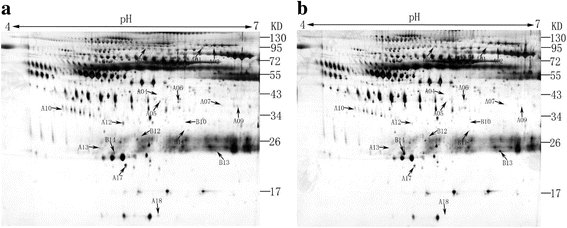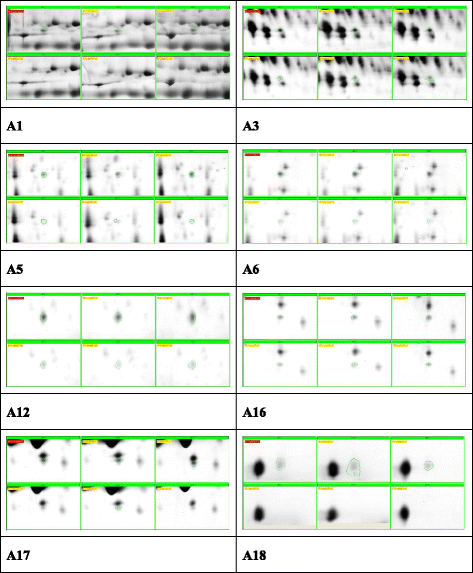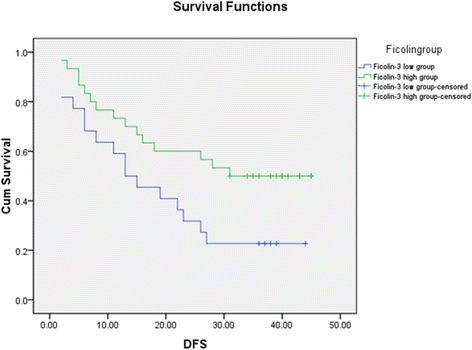Screening for immune-potentiating antigens from hepatocellular carcinoma patients after radiofrequency ablation by serum proteomic analysis
- PMID: 29386009
- PMCID: PMC5793368
- DOI: 10.1186/s12885-018-4011-8
Screening for immune-potentiating antigens from hepatocellular carcinoma patients after radiofrequency ablation by serum proteomic analysis
Abstract
Background: Radiofrequency ablation (RFA) can not only effectively kill hepatocellular carcinoma (HCC) tumour cells but also release tumour antigens that can provoke an immune response. However, there is no consensus regarding which antigens could constitutively be generated after RFA and could potentiate the immune response. The aim of this study was to identify these immune-potentiating antigens.
Methods: We performed two-dimensional electrophoresis (2-DE) and MALDI-TOF-MS/MS analyses on serum obtained before and after RFA from 5 HCC patients. Further validation for selected proteins was performed utilizing ELISA analysis on another 52 HCC patients. Disease-free survival (DFS) analysis according to the differential expression of the interested protein before and after RFA was performed.
Results: Twelve decreased and 6 increased proteins after RFA were identified by MS. Three proteins, including clusterin, Ficolin-3, and serum retinol binding protein-4, were further verified by ELISA on the 52 HCC patients. Only Ficolin-3 proved to be significantly changed after RFA. The 52 patients were divided into two groups according to the expression of Ficolin-3 before and after RFA. The 1-, 2- and 3-year DFS rates were 59.1%, 31.8%, and 22.7%, respectively, for patients in the low Ficolin-3 group (22 patients) and 73.3%, 60.0%, and 50.0%, respectively, for patients in the high Ficolin-3 group (30 patients) (P = 0.038).
Conclusions: In conclusion, Ficolin-3 was overexpressed in the serum of most HCC patients after RFA. Ficolin-3 might be a biomarker for RFA treatment efficacy and a potential target for HCC immunotherapy.
Keywords: Ficolin-3; Hepatocellular carcinoma; Immunotherapy; Proteomics; Radiofrequency ablation.
Conflict of interest statement
Ethics approval and consent to participate
This study was performed according to the guidelines of the Helsinki Declaration. It was registered and approved by the ethics committee at The First Affiliated Hospital of Sun Yat-sen University. All patients provided written informed consent before treatment.
Consent for publication
N/A.
Competing interests
The authors declare that they have no competing interests.
Publisher’s Note
Springer Nature remains neutral with regard to jurisdictional claims in published maps and institutional affiliations.
Figures





References
-
- Wissniowski TT, Hänsler J, Neureiter D, Frieser M, Schaber S, Esslinger B, Voll R, Strobel D, Hahn EG, Schuppan D, Wissniowski TT, Hünsler J. Activation of tumor-specific T lymphocytes by radio-frequency ablation of the VX2 hepatoma in rabbits. Cancer Res. 2003;63(19):6496–6500. - PubMed
Publication types
MeSH terms
Substances
Grants and funding
- 09ykpy30/the Fundamental Research Funds for the Central Universities/International
- 15ykpy15/the Fundamental Research Funds for the Central Universities/International
- 2014Y2-00129/the Science and Technology Project of Guangzhou/International
- 2014A030313108/Natural Science Foundation of Guangdong Province/International
- 81272312/National Natural Science Foundation of China/International
LinkOut - more resources
Full Text Sources
Other Literature Sources
Medical
Miscellaneous

